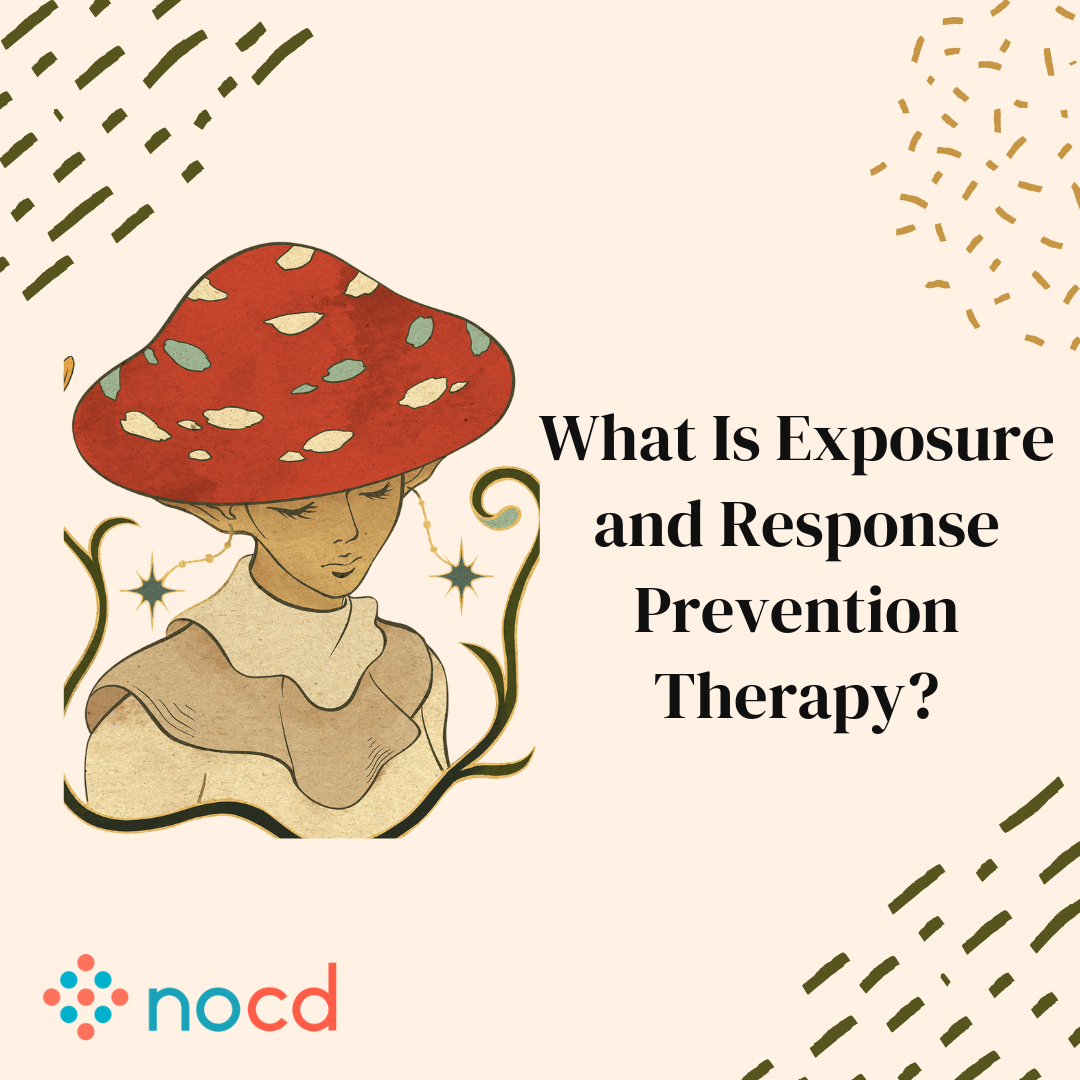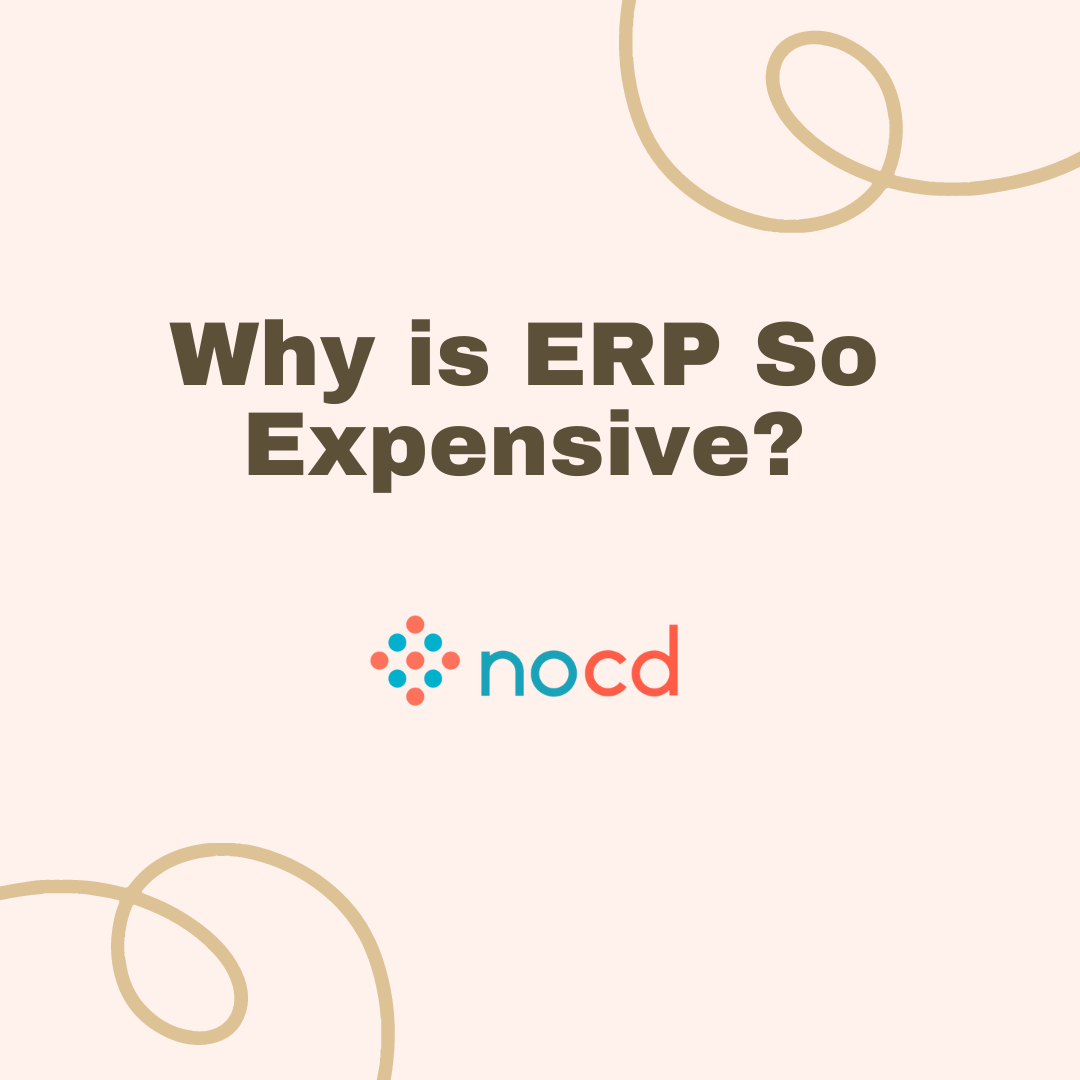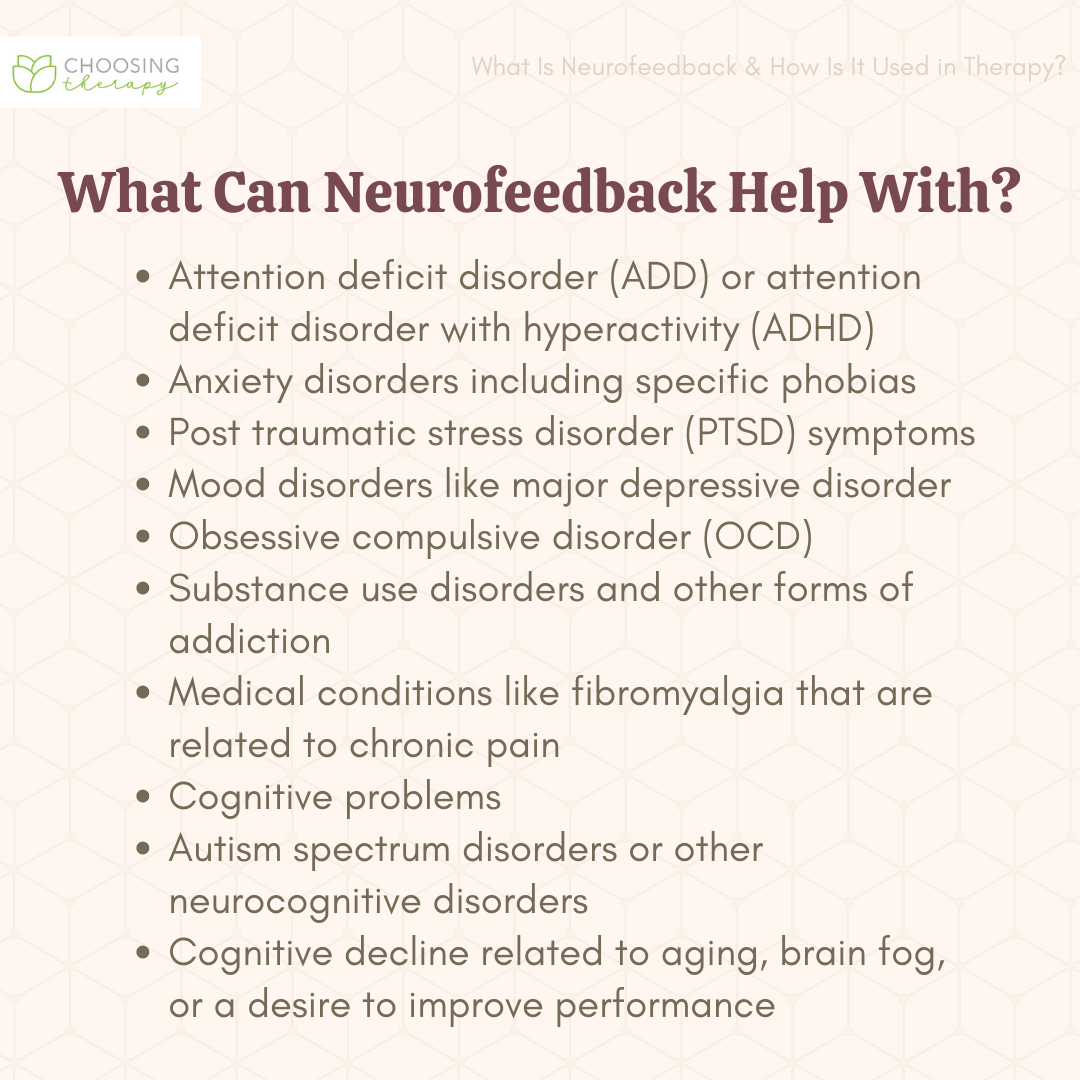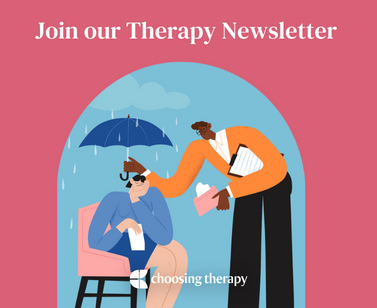Neurofeedback monitors and corrects abnormal brain waves related to a variety of mental and cognitive disorders. It provides real-time data about what’s happening in the brain while people complete different tasks.1,2,3,4,5 Feedback is used to regulate and stabilize abnormal brain waves, and improve cognitive functioning, mood, and symptoms of a variety of mental health concerns.1,3,5
Would you like to try therapy? Find a supportive and compassionate therapist! BetterHelp has over 20,000 licensed therapists who provide convenient and affordable online therapy. BetterHelp starts at $65 per week. Take a Free Online Assessment and get matched with the right therapist for you.
What Is Neurofeedback?
Neurofeedback (NFB or just NF) is a type of biofeedback that monitors and adjusts brain waves. Research has found that people with cognitive problems or mental health issues have abnormal brain wave activities.1,3,5,6 Specifically, it’s been discovered that the brain waves in people with issues like ADHD, anxiety, depression, and PTSD are irregular. Neurofeedback aims to correct these abnormalities using operant conditioning techniques.1,2,5,7
Most neurofeedback today is delivered using a computer-based program that links to an EEG sensor tracking a person’s brain waves as they watch, listen, read, or do other tasks on a screen. These systems can adjust what the person is seeing, hearing, or doing, which prompts the desired brain wave response while also teaching them how to regulate their brain activity.1,3,7
How Does Neurofeedback Therapy Work?
Neurofeedback provides real-time data about brain waves in response to different images, skills, tasks, and activities.1,5,8 People undergoing this treatment may be asked to perform tasks like reading, solving math problems, watching videos, or listening to music. During these activities, their brain wave patterns are monitored, recorded, and made available. When abnormal brain waves are detected, the computer may automatically redirect them to a different task or activity.1,2,5,7
A key to understanding how neurofeedback works is the concept of neuroplasticity, which describes how the human brain is continuously learning and changing in response to experiences, environment, and choices. Neurofeedback claims to prompt these changes in the brain to create new neural pathways.1,3,5
Over time, the brain can be conditioned to solidify new neural pathways, leading to lasting changes.1,5,8 This has been demonstrated in certain studies showing that between 70-80% of people treated with neurofeedback experienced a dramatic improvement in symptoms, including 80-85% reduction in symptoms. These results were maintained in post treatment follow-ups of six months, a year, and sometimes even several years.1,3,7
Types of Neurofeedback
There are various types of neurofeedback, each of which support the treatment of specific conditions:
- Amplitude training: This helps to improve symptoms associated with depression and anxiety, as well as ADHD for some.
- Slow cortical training: This supports people with diagnoses of migraines and epilepsy.
- Z-score training: This helps to address the underlying reasons causing insomnia.
What Is Neurofeedback Therapy Used For?
Neurofeedback has been around since the ‘70s, but it has been gaining new popularity in areas of mental health treatment. Although some experts have scrutinized NFB studies and more research is needed to determine its efficacy, there are several documented success stories for people struggling with issues like ADHD, anxiety disorders, and PTSD.2,4,6,8,9,10,11,12
Neurofeedback can help with:
- Attention deficit/hyperactivity disorder (ADHD)
- Anxiety disorders including social anxiety, panic disorder, and specific phobias
- Post traumatic stress disorder (PTSD) symptoms
- Mood disorders like major depressive disorder, anger issues or mood swings
- Obsessive compulsive disorder (OCD)
- Substance use disorders and other forms of addiction
- Certain sleep disorders like insomnia
- Medical conditions like fibromyalgia that are related to chronic pain
- Cognitive problems related to memory, focus, or concentration
- Autism spectrum disorders or other neurocognitive disorders
- Neurological conditions like seizure disorders and migraines
- Cognitive decline related to aging, brain fog, or a desire to improve performance
Top Rated Online Therapy Services BetterHelp – Best Overall “BetterHelp is an online therapy platform that quickly connects you with a licensed counselor or therapist and earned 4 out of 5 stars.” Visit BetterHelp Talkspace - Best For Insurance Talkspace accepts many insurance plans including Optum, Cigna, and Aetna. Typical co-pay is $30, but often less. Visit Talkspace
What to Expect at a Neurofeedback Therapy Session
Most people who enter therapy expect to receive traditional talk therapy, which involves sitting down and talking with a licensed therapist to understand and overcome issues related to mental health. Neurofeedback therapy is quite different from this ‘traditional’ model of therapy, and many clients interested in the treatment aren’t quite sure what to expect in an NFB session.
Here is some information on what to expect in a neurofeedback session:
Sessions May Not Occur In a Therapy Office
Neurofeedback is provided in a number of different settings, including medical facilities, hospitals, or clinics that have direct access to brain imaging technology and staff to interpret them. More recently, advances in computer-based neurofeedback have made the treatment more accessible, which has led to NFB being offered in schools, therapy offices, and other non-medical facilities.
In some cases, neurofeedback can be done from the comfort of your own home, although home-based NFB is not as effective as sessions that occur with a licensed or experienced clinician.1,3,5,7,8
You’ll Fill Out Paperwork & Complete Forms & Questionnaires
Similar to a counseling appointment, NFB treatment can’t begin until you fill out certain forms and sign documents consenting to the treatment. Read these carefully so you understand the process. Use this as an opportunity to ask questions about anything you’re unclear about. Some of these forms may be mental health questionnaires that help to diagnose and assess the severity of conditions like anxiety, depression, PTSD, or chronic pain.
A Therapist May Not Be Leading Your Treatment
Neurofeedback used to be primarily administered by medical professionals with access to brain imaging technology like fMRI machines and EEG sensors.2,5,6 Today, EEG technology is more affordable and accessible, and many NFB programs are automated using computer interfaces, meaning a counselor or therapist may not be directly involved in your treatment.3,11
Images or Sensors Establish a “Baseline” of Brain Waves
It’s important for a neurofeedback clinician to understand your “normal” brain wave activity, so the first appointment normally involves taking recordings of your brain waves using an EEG machine. Painless electrode sensors are placed on your head to monitor brain waves. Less commonly, fMRI machines will be used which involve lying in a high-tech tube-like container that takes images of your brain.2,3,6
Discussion of Results & Review of Treatment Recommendations
After the first session, a clinician will discuss your results and recommended treatments using the data collected during the first treatment. QEEG (quantitative EEG) results are like a picture of your brain that maps out activity in different regions that may correspond to the issues or problems you’re having. The clinician may recommend that you complete a full course of NFB, normally involving 20-40 weekly sessions.1,2,3,5
You’ll Watch Different Videos, Images, or Be Asked to Try Different Skills
After your initial NFB, you can expect for each session to include EEG electrodes being placed on your head while you watch, listen, or do certain things on a screen. An average session is about 30 minutes, but some may be as short as 15 minutes or as long as an hour, depending on your needs.1,3
During this time, you may be asked to watch or listen to a mindfulness activity, read, solve a math equation, or play music or a video game. These activities are all used to elicit different brain wave responses.3
You Will Get Immediate Feedback In Sessions About Brain Waves
Neurofeedback always involves giving you real-time feedback about what’s happening in your brain.2,3,5 This is designed to help you understand the way you’re emotionally responding and cue you to use different skills to slow or stabilize your brain waves.3
Many NFB clinics use headphones to play specific tones when your brain waves enter into a more erratic pattern. Some send pulses into your brain to activate certain regions or provide cues, but most just use video or audio cues.1,3,8
Operant Conditioning Retrains Your Brain & Optimizes Brain Waves
A core element of NFB involves operant conditioning, a behavioral therapy that uses positive or negative consequences to stop or encourage certain responses.1,3,7,8 The consequences in NFB are subtle, and may simply involve a change in the activity, image, or video on the screen. Even cues that alert you about irregular brain waves can be a kind of “consequence” that helps condition and retrain your brain.
You Will Continue Treatments Until You Reach Optimal Brain Wave Activity
Depending on your problem, the “optimal” brain wave may be slower and calmer (i.e., for PTSD or anxiety) or faster and more focused (i.e., for cognitive difficulties or ADHD).1,3 NFB sessions normally establish a goal early on that’s based on your baseline brain waves and current symptoms. Most people require 20-40 sessions to see optimal results.1,7,9 In some cases, people only need about 10 sessions (e.g., insomnia).3
Treatment Will Be Continued, Adjusted, or Terminated Based On Progress
Progress is discussed at almost every session, since the whole goal of NFB is to use data and real-time feedback to help you track and adjust your brain activity.1,2,3,5 In the event that you’re not making progress, treatment may be adjusted or other types of therapy may be recommended as an addition or replacement.
How Long Will It Take?
Neurofeedback is a therapeutic process that takes time to work. It can take up to a month to feel the impact. People tend to feel the benefits after about 10-15 sessions. Depending on your reasons and goals of treatment, the number of sessions and the time of each session can vary. On average, neurofeedback therapy sessions last 45-60 minutes.
Find the perfect therapist for you, with BetterHelp. If you don’t click with your first match, you can easily switch therapists. BetterHelp has over 20,000 licensed therapists who provide convenient and affordable online therapy. BetterHelp starts at $65 per week. Take a Free Online Assessment and get matched with the right therapist for you.
Examples of Neurofeedback Therapy
Because neurofeedback is very different from traditional talk therapy, a lot of people are unsure of what to expect in treatment.
Here are three scenarios that exemplify what to expect in neurofeedback therapy:
1. Neurofeedback for a Child With ADHD
Some of the strongest evidence for the effectiveness of neurofeedback for ADHD is for children, teens, and adults with attention deficit disorders.3,9,10 During a neurofeedback session with a younger child, they will often be sitting with headphones on in front of a screen that’s showing them different images, videos, and activities. During this time, their brainwaves are monitored and different tasks are presented to trigger optimal brainwaves.
For people with ADHD, the optimal brain wave pattern usually involves lowering high beta waves.1,3,7 According to studies, children with symptoms of ADHD who completed NFB treatment experienced better, more rapid and lasting improvements in their symptoms compared to those treated with cognitive therapy.
80% in the NFB treatment group were able to reduce their use of prescription stimulants by 50% and maintained these improvements at a 6-month follow up.1,3,9,10
2. Neurofeedback For Symptoms of Anxiety
The goal of NFB for people with anxiety symptoms is to reduce high beta waves.1,3,8 This can be done by exposing people to calming and relaxing images, videos, and guided meditations during sessions. When their brainwaves show sustained beta wave reduction, they will often get a cue from the screen or their headphones that acts as a reward to let them know they made progress.
While there’s been controversy about some of the studies conducted on neurofeedback, more emerging research suggests that it can help people struggling with anxiety.1,3,6,8 One study found that veterans with PTSD who received NFB experienced only a 20% return in panic attacks.
Other studies have found that combining neurofeedback with other treatments like CBT for anxiety, mindfulness-based therapies, or talk therapy can enhance the benefits for people with anxiety.8
3. Neurofeedback for Cognitive & Neurological Problems
Neurofeedback has been used for people struggling with cognitive and neurological conditions like seizures, migraines, and problems with learning, memory, or concentration. Many of these studies have found that NFB can be effective in improving cognitive functioning. Children with developmental and learning disorders seem to benefit the most from NFB, with one study showing a 12 point increase in IQ scores.1,3
For example, higher alpha or beta waves are often the goal of people looking to enhance their cognitive performance1,3 These can be achieved by helping stimulate these brain waves while they engage in a mentally challenging task and rewarding them when they reach optimal brain waves.
People struggling with migraines and seizures often benefit from neurofeedback sessions that focus on increasing low beta brain waves. Some studies have found 70% reductions in seizures in people treated with neurofeedback.1
Neurofeedback Therapy Cost
People seeking neurofeedback in schools, outpatient clinics, or mental health offices may pay less for care, with $50-$130 being the average cost per session.12 In general, the cost varies depending on where you live, what kind of treatment you receive, and where you receive it. Medical clinics and hospitals may charge more, but may also have access to higher tech devices and better trained medical staff.3
Whether or not neurofeedback is covered by your mental health insurance depends on your particular plan, the provider you choose, and what you’re seeking treatment for. One benefit of seeking NFB from a medical clinic or hospital is that the treatment may be more likely to be covered by insurance, as these larger medical institutions are usually in-network providers with a number of different insurance plans.
There’s also a higher likelihood of getting insurance to cover neurofeedback for conditions that have more research to support the use of NFB. These include ADHD (especially for children or teens), PTSD, and some anxiety or neurological disorders.3,9,10,11,12,13 In cases where NFB isn’t covered by insurance, it’s sometimes possible to use an HSA card to pay for sessions. Also, discuss scholarships or sliding scale options for people with lower incomes.
Who Is Able to Offer Neurofeedback?
A person doesn’t need to be a licensed therapist to provide neurofeedback, and not all professionals who offer NFB are properly trained or credentialed.3,11,12 Training and certification programs exist, but aren’t mandatory to be able to provide NFB. Because most neurofeedback is computerized, it requires less involvement from a clinician.
Medical professionals, counselors, school personnel, and others in health or mental health can offer this service. Still, many who decide to provide NFB do seek out training and some even get credentialed by the BCIA (Biofeedback Certification International Alliance). This is considered the “gold standard” for neurofeedback, as it requires extensive training, mentoring, supervised practice hours, and passing a credentialing exam.11
“Levels” of certification exist for people with different educational and professional backgrounds and those who pursue more rigorous training from the organization.
Professionals who are able to become BCIA certified include:11
- Licensed mental health counselors, social workers, and psychologists
- Physical and occupational therapists, chiropractors, and sports medicine specialists
- Medical doctors, nurses, and other licensed healthcare providers
- Rehabilitation, recreation, and and speech therapists
Would you like to try therapy? Find a supportive and compassionate therapist! BetterHelp has over 20,000 licensed therapists who provide convenient and affordable online therapy. BetterHelp starts at $65 per week. Take a Free Online Assessment and get matched with the right therapist for you.
How to Find a Therapist Who Provides Neurofeedback
One way to find a highly trained NFB provider is to use an online therapist directory that allows you to narrow your search by specialty areas of practice. You could also search for local hospitals or universities near you that offer this treatment.
Narrow your options down to a few different providers or agencies that provide this treatment, then call to ask questions or request a consultation. This allows you to learn more about the treatment, provider skill and qualifications, and associated costs.3,11,12,13
Is Neurofeedback Effective?
The research on the effectiveness of NFB is mixed, so we aren’t able to make any firm conclusions that neurofeedback is effective in treating mental health conditions at this time.2,3,4,6 Many of the studies used to “prove” that neurofeedback works have been criticized for being poorly designed or conducted. Ultimately, there’s a need for more research.2,4,6,8,9
Statistics On Neurofeedback Successes
While not all of the research has consistently shown that neurofeedback is effective, some studies show promising results. This suggests that at least for certain people, NFB is an effective treatment for certain disorders.
Here are some recent statistic on the effectiveness of neurofeedback:1,3,5,7,10
- Approximately 70-80% of people who receive NFB improve
- Of those who improve, the rate of improvement in symptoms is about 80-85%
- NFB can reduce seizures by 70% in patients with epilepsy who weren’t responding to medication or other treatments
- NFB can treat addiction, with over 90% of NF treated people remaining sober at a 21 month follow up
- Children with learning problems tend to make consistent progress in NFB, and can even raise their IQ by an average of 12 points after NFB
- Panic attacks in veterans with PTSD dropped to about 20% after NFB
- EEG neurofeedback can reduce symptoms of PTSD, anxiety, chronic pain, neurological problems, and depression
- Insomnia can often be resolved in just 10 neurofeedback sessions
It is important to acknowledge that not every study on neurofeedback has produced the same robust results.
Risks of Neurofeedback Therapy
There are some drawbacks to neurofeedback, including the high cost associated with needing 20-40 sessions and the mixed data on its efficacy.1,3,6,8 There’s also a risk that neurofeedback is an unregulated treatment, and not all providers are required to receive adequate training.3,11
Still, the actual risks associated with treatment are relatively rare and when they do occur, tend to be mild. Mild headaches following sessions are the most common adverse effect after neurofeedback.1,7
Criticisms of Neurofeedback Therapy
Criticism of neurofeedback has been widespread, with many experts citing a lack of evidence to support its efficacy. Also, the brain science behind neurofeedback is not well established, and not all experts agree that specific brain wave patterns are related to specific disorders. Many argue that human brains are too diverse to “map,” and that a number of different factors could describe ‘abnormalities’ in brain wave activity.
The strongest criticism on NFB centers around the idea that some of the studies used to cite its efficacy have been poorly constructed and biased.2,4,5,6
Neurofeedback Vs. Psychiatric Interventions
Neurofeedback may have some benefit, however more research is needed. It has shown to have benefits and effectiveness for the treatment of various conditions, however psychiatric interventions such as medication and talk therapy continue to be the gold standard of treatment. Neurofeedback may be a beneficial tool to use in conjunction with talk therapy and medication to improve symptom management.
Final Thoughts on Neurofeedback
There is much that we still don’t fully understand about brain activity, including brainwaves. Some research suggests that neurofeedback can help people struggling with issues like ADD, ADHD, PTSD, anxiety, addiction, and neurological/mood disorders, but not enough to claim it’s an evidence-based practice.1,2,3,13 In the coming years, more sound research will likely emerge to help determine how effective this treatment is and who could benefit.
To help our readers take the next step in their mental health journey, Choosing Therapy has partnered with leaders in mental health and wellness. Choosing Therapy is compensated for marketing by the companies included below. Online Therapy BetterHelp – Get support and guidance from a licensed therapist. BetterHelp has over 20,000 therapists who provide convenient and affordable online therapy. Take A Free Online Assessment and get matched with the right therapist for you. Free Assessment Online Psychiatry Hims / Hers If you’re living with anxiety or depression, finding the right medication match may make all the difference. Connect with a licensed healthcare provider in just 12 – 48 hours. Explore FDA-approved treatment options and get free shipping, if prescribed. No insurance required. Get Started Medication + Therapy Brightside Health – Together, medication and therapy can help you feel like yourself, faster. Brightside Health treatment plans start at $95 per month. United Healthcare, Anthem, Cigna, and Aetna accepted. Following a free online evaluation and receiving a prescription, you can get FDA approved medications delivered to your door. Free Assessment Starting Therapy Newsletter A free newsletter for those interested in learning about therapy and how to get the most benefits out of therapy. Get helpful tips and the latest information. Sign Up Choosing Therapy Directory You can search for therapists by specialty, experience, insurance, or price, and location. Find a therapist today.Additional Resources
For Further Reading
What Is Exposure and Response Prevention Therapy? ERP therapy alters OCD’s pattern by addressing both obsessions and compulsions. In ERP, an individual is encouraged to confront the stimuli that trigger distress related to their obsessions while also resisting the urge to perform compulsions in an attempt to reduce their distress.
Why is ERP So Expensive? There are hundreds of OCD tests and “OCD quizzes” online. Some aim to help people self-diagnose; others turn obsessive-compulsive disorder into a joke. Either way, a vast majority of these are not helpful and probably create more problems than solutions.








